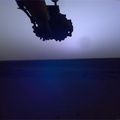
WIKIARCHIVES.SPACE
The Human Spaceflight Archive

NASA's InSight lander snapped a series of images of the Sun rising and setting on Mars using the camera on its robotic arm on April 10, 2022, the 1,198th Martian day, or sol, of the mission.
Information
- Taken in
- Author
- NASA/JPL-Caltech
- Description
-
NASA's InSight lander snapped a series of images of the Sun rising and setting on Mars using the camera on its robotic arm on April 10, 2022, the 1,198th Martian day, or sol, of the mission.
Figure A shows the Sun rising; Figure B shows the Sun setting. These images are color-calibrated to appear as the human eye would see them on Mars. Dust-sized particles in the Martian atmosphere affect the way sunlight scatters. This effect makes the Martian sky look blue near the Sun, with tinges of purple or gray at sunrise and sunset.
JPL manages InSight for NASA's Science Mission Directorate. InSight is part of NASA's Discovery Program, managed by the agency's Marshall Space Flight Center in Huntsville, Alabama. Lockheed Martin Space in Denver built the InSight spacecraft, including its cruise stage and lander, and supports spacecraft operations for the mission.
A number of European partners, including France's Centre National d'Études Spatiales (CNES) and the German Aerospace Center (DLR), are supporting the InSight mission. CNES provided the Seismic Experiment for Interior Structure (SEIS) instrument to NASA, with the principal investigator at IPGP (Institut de Physique du Globe de Paris). Significant contributions for SEIS came from IPGP; the Max Planck Institute for Solar System Research (MPS) in Germany; the Swiss Federal Institute of Technology (ETH Zurich) in Switzerland; Imperial College London and Oxford University in the United Kingdom; and JPL. DLR provided the Heat Flow and Physical Properties Package (HP3) instrument, with significant contributions from the Space Research Center (CBK) of the Polish Academy of Sciences and Astronika in Poland. Spain's Centro de Astrobiología (CAB) supplied the temperature and wind sensors.
- Created on
- Friday 15 April 2022
- Albums
- US SPACE PROGRAM / PROBES / MARS / INSIGHT / Mission Photos (Edited)
- Source link
- https://photojournal.jpl.nasa.gov
- Visits
- 25
- Rating score
- no rate
- Rate this photo
- License
- Public Domain
- Modified by WikiArchives
- No (original)
- Downloads
- 2
Powered by Piwigo





